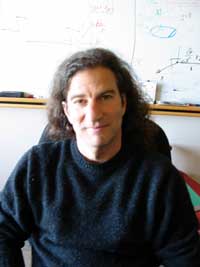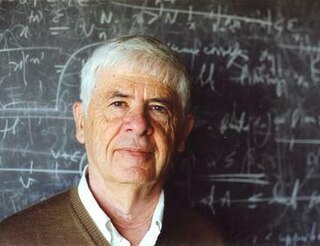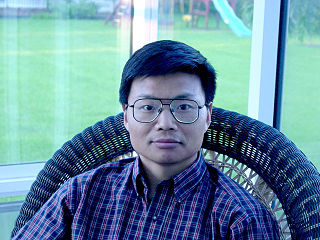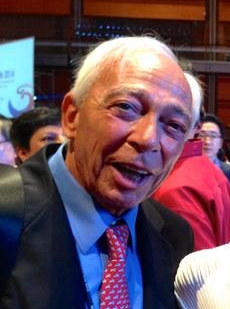Related Research Articles

Computational fluid dynamics (CFD) is a branch of fluid mechanics that uses numerical analysis and data structures to analyze and solve problems that involve fluid flows. Computers are used to perform the calculations required to simulate the free-stream flow of the fluid, and the interaction of the fluid with surfaces defined by boundary conditions. With high-speed supercomputers, better solutions can be achieved, and are often required to solve the largest and most complex problems. Ongoing research yields software that improves the accuracy and speed of complex simulation scenarios such as transonic or turbulent flows. Initial validation of such software is typically performed using experimental apparatus such as wind tunnels. In addition, previously performed analytical or empirical analysis of a particular problem can be used for comparison. A final validation is often performed using full-scale testing, such as flight tests.
In numerical analysis, a multigrid method is an algorithm for solving differential equations using a hierarchy of discretizations. They are an example of a class of techniques called multiresolution methods, very useful in problems exhibiting multiple scales of behavior. For example, many basic relaxation methods exhibit different rates of convergence for short- and long-wavelength components, suggesting these different scales be treated differently, as in a Fourier analysis approach to multigrid. MG methods can be used as solvers as well as preconditioners.

James Albert Sethian is a professor of mathematics at the University of California, Berkeley and the head of the Mathematics Group at the United States Department of Energy's Lawrence Berkeley National Laboratory.

Bram van Leer is Arthur B. Modine Emeritus Professor of aerospace engineering at the University of Michigan, in Ann Arbor. He specializes in Computational fluid dynamics (CFD), fluid dynamics, and numerical analysis. His most influential work lies in CFD, a field he helped modernize from 1970 onwards. An appraisal of his early work has been given by C. Hirsch (1979)

Alexandre Joel Chorin is an American mathematician known for his contributions to computational fluid mechanics, turbulence, and computational statistical mechanics.

Thomas Joseph Robert Hughes is a Professor of Aerospace Engineering and Engineering Mechanics and currently holds the Computational and Applied Mathematics Chair (III) at the Oden Institute at The University of Texas at Austin. Hughes has been listed as an ISI Highly Cited Author in Engineering by the ISI Web of Knowledge, Thomson Scientific Company.
Roger Meyer Temam is a French applied mathematician working in numerical analysis, nonlinear partial differential equations and fluid mechanics. He graduated from the University of Paris – the Sorbonne in 1967, completing a doctorate under the direction of Jacques-Louis Lions. He has published over 400 articles, as well as 12 books.

Randall J.. LeVeque is a Professor of Applied Mathematics at University of Washington who works in many fields including numerical analysis, computational fluid dynamics, and mathematical theory of conservation laws. Among other contributions, he is lead developer of the open source software project Clawpack for solving hyperbolic partial differential equations using the finite volume method. With Zhilin Li, he has also devised a numerical technique called the immersed interface method for solving problems with elastic boundaries or surface tension.

Phillip Colella is an American applied mathematician and a member of the Applied Numerical Algorithms Group at the Lawrence Berkeley National Laboratory. He has also worked at Lawrence Livermore National Laboratory. He is known for his fundamental contributions in the development of mathematical methods and numerical tools used to solve partial differential equations, including high-resolution and adaptive mesh refinement schemes. Colella is a member of the US National Academy of Sciences.
In applied mathematics, the name finite pointset method is a general approach for the numerical solution of problems in continuum mechanics, such as the simulation of fluid flows. In this approach the medium is represented by a finite set of points, each endowed with the relevant local properties of the medium such as density, velocity, pressure, and temperature.

Weinan E is a Chinese mathematician. He is known for his pathbreaking work in applied mathematics and machine learning. His academic contributions include novel mathematical and computational results in stochastic differential equations; design of efficient algorithms to compute multiscale and multiphysics problems, particularly those arising in fluid dynamics and chemistry; and pioneering work on the application of deep learning techniques to scientific computing. In addition, he has worked on multiscale modeling and the study of rare events.
Catherine Sulem is a mathematician and violinist at the University of Toronto.

George Em Karniadakis is a professor of applied mathematics at Brown University. He is a Greek-American researcher who is known for his wide-spectrum work on high-dimensional stochastic modeling and multiscale simulations of physical and biological systems, and is a pioneer of spectral/hp-element methods for fluids in complex geometries, general polynomial chaos for uncertainty quantification, and the Sturm-Liouville theory for partial differential equations and fractional calculus.

Franco Brezzi is an Italian mathematician.
Helena Judith Nussenzveig Lopes is a Brazilian mathematician, known for her work on the Euler equations for incompressible flow in fluid dynamics. She is a professor titular in the Department of Mathematical Methods at the Federal University of Rio de Janeiro.
Tang Tao is a Chinese mathematician currently serving as President of BNU-HKBU United International College. Tang is a member of the Chinese Academy of Sciences, Fellow of the European Academy of Sciences, Fellow of The World Academy of Sciences for the advancement of science in developing countries (TWAS). He is also a fellow of the Society for Industrial and Applied Mathematics and American Mathematical Society.
Weizhu Bao is a Chinese mathematician at the National University of Singapore (NUS). He is known for his work in applied mathematics with applications in quantum physics and chemistry and materials science, especially Bose-Einstein condensation (BEC) and highly oscillatory partial differential equations.
The variational multiscale method (VMS) is a technique used for deriving models and numerical methods for multiscale phenomena. The VMS framework has been mainly applied to design stabilized finite element methods in which stability of the standard Galerkin method is not ensured both in terms of singular perturbation and of compatibility conditions with the finite element spaces.
James Thomas Beale is an American mathematician, specializing in fluid dynamics, partial differential equations, and numerical analysis.
David James Silvester is a British numerical analyst. He has a Chair in Numerical Analysis and is the Head of Applied Mathematics in the Department of Mathematics at the University of Manchester.
References
- 1 2 Thomas Y. Hou curriculum vitae Retrieved 11 August 2014
- ↑ Thomas Yizhao Hou at the Mathematics Genealogy Project
- ↑ Efendiev, Yalchin; Hou, Thomas (2009), Multiscale finite element methods, Springer
- ↑ Hou, Thomas Y. (2022-09-07). "Potentially Singular Behavior of the 3D Navier–Stokes Equations". Foundations of Computational Mathematics. arXiv: 2107.06509 . doi:10.1007/s10208-022-09578-4. ISSN 1615-3383. S2CID 249152330.
- ↑ Chen, Jiajie; Hou, Thomas Y. (2022-10-13). "Stable nearly self-similar blowup of the 2D Boussinesq and 3D Euler equations with smooth data". arXiv: 2210.07191v2 [math.AP].
- ↑ "Quanta magazine".
- ↑ Hou, Thomas Y. (2022-09-07). "Potentially Singular Behavior of the 3D Navier–Stokes Equations". Foundations of Computational Mathematics. arXiv: 2107.06509 . doi:10.1007/s10208-022-09578-4. ISSN 1615-3383. S2CID 249152330.
- ↑ Chang, Y. C.; Hou, T. Y.; Merriman, B.; Osher, S. (1996-03-15). "A Level Set Formulation of Eulerian Interface Capturing Methods for Incompressible Fluid Flows". Journal of Computational Physics. 124 (2): 449–464. doi:10.1006/jcph.1996.0072. ISSN 0021-9991.
- ↑ Hou, Thomas Y.; Lowengrub, John S.; Shelley, Michael J. (1994-10-01). "Removing the stiffness from interfacial flows with surface tension". Journal of Computational Physics. 114 (2): 312–338. doi: 10.1006/jcph.1994.1170 . ISSN 0021-9991.
- ↑ Sloan Foundation, Past Fellows
- ↑ Feng Kang Prize, past winners
- ↑ "Prizes & Awards - Unit - DFD". engage.aps.org. Retrieved 2023-04-21.
- ↑ James H. Wilkinson prize from the Society for Industrial and Applied Mathematics.
- ↑ "Award Recipients". www.usacm.org. Retrieved 2023-04-21.
- ↑ "SIAM Outstanding Paper Prizes". SIAM. Retrieved 2023-04-21.
- ↑ "Professor Thomas Hou Receives Ralph E. Kleinman Prize". Computing + Mathematical Sciences. 2023-01-03. Retrieved 2023-04-21.
- ↑ ICM Plenary and Invited Speakers since 1897 at International Mathematical Union
- ↑ Hou, Thomas Yizhao (1998). "Numerical study of free interface problems using boundary integral methods". Doc. Math. (Bielefeld) Extra Vol. ICM Berlin, 1998, vol. III. pp. 601–610.
- ↑ "Congress Update: ICIAM 2003", news item from at Society for Industrial and Applied Mathematics
- ↑ SIAM Fellows, Class of 2009
- ↑ American Academy of Arts and Sciences, Membership
- ↑ List of Fellows of the American Mathematical Society